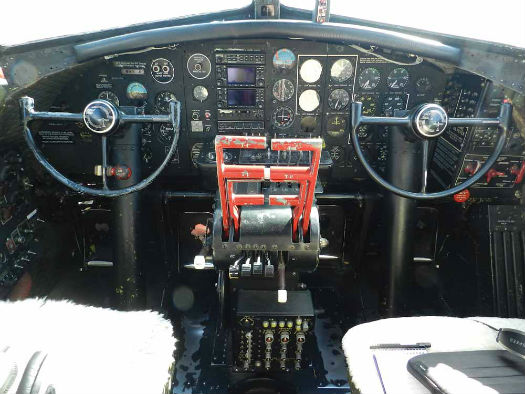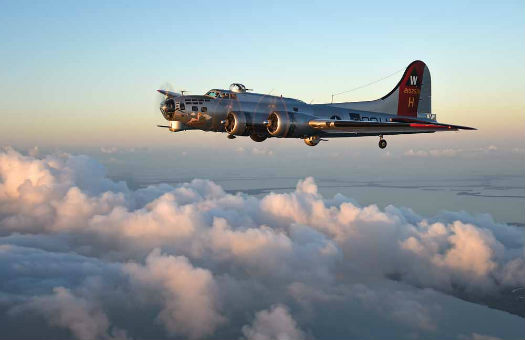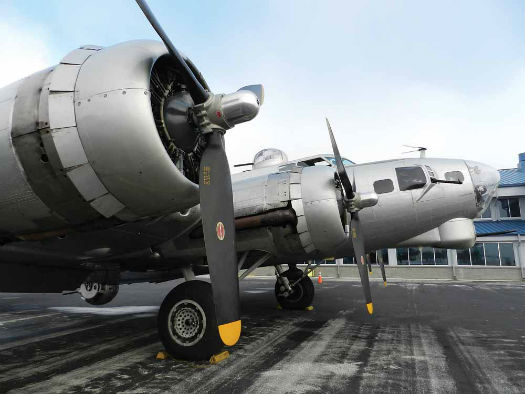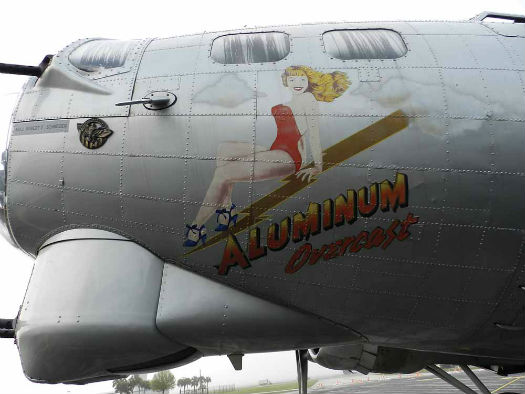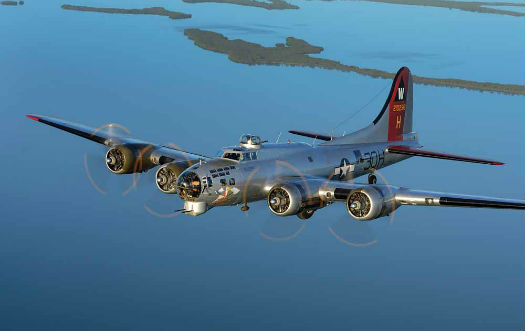From the right seat, Sean Elliot, my B-17 bomber check pilot, offered a few words of encouragement as we started taxiing. As the edge of the airport ramp approached, I depressed a rudder pedal. Nothing happened. The B-17’s castering tailwheel doesn’t respond to pedal inputs, nor did the propellers provide any slipstream over the rudder. Elliot sat, arms crossed and smiling. I hastily jabbed the brakes to start a turn. I was rewarded with an admonishing glance from Elliot, having been warned to avoid the use of brakes as parts are now rare and expensive.
Taxiing, I discovered, involved judicious use of differential throttle to initiate a turn. Then I further discovered that, once turning, the big B-17 exhibits considerable momentum, so an opposite twist of the throttles was required to arrest it. Waddling awkwardly toward the runway, the B-17 seemed to be saying that it had a lot to teach me.
Only about a dozen B-17s are still airworthy, so an hour in the left seat was a rare privilege. It was also a unique opportunity for Skies’ test pilot Rob Erdos to see how the Second World War looked from the perspective of the courageous aircrew who flew heavy bombers. Brady Lane/EAA Photo
I didn’t just stumble unprepared into flying the B-17. The Experimental Aircraft Association (EAA) extended Skies magazine an invitation to attend the annual groundschool for their B-17 pilots in Lakeland, Fla. About a dozen lucky pilots assembled for recurrent training in support of EAA’s air tour program, which brings Aluminum Overcast to communities around the country.
A total of 12,731 B-17s, plus several prototypes, were manufactured during the Second World War by the Boeing, Douglas and Lockheed companies. Only about a dozen B-17s remain airworthy, so an hour in the left seat was a rare privilege indeed, and a unique opportunity to see how WWII looked from the perspective of the courageous aircrew who flew heavy bombers.
The Florida Bomber Offensive
The B-17 is an iconic bomber of wartime fame, but its first flight was in 1935, so it was in fact a pre-WWII aircraft. The design reflects how people thought heavy bombers were going to fight a war; that is, armed to the teeth. Implicit in the name “Flying Fortress” was Boeing’s notion that, with sufficient defensive firepower, the B-17 could fight its way in and out of enemy airspace. In practice, fighter escort proved essential—but Aluminum Overcast, a B-17G variant, bristled with 13 50-calibre Browning machine guns.
Aluminum Overcast’s cockpit is a mixture of old and new. The throttles are unique to the B-17; an idea that fortunately never caught on. Rob Erdos Photo
Prior to my turn at the controls I was offered a chance to ride along as B-17 instructor Bob Davis ran a group of other pilots through their annual check rides. It was a wonderful opportunity to sample the other crew positions. I stared in disbelief at the belly-mounted ball turret. It seemed impossible that anyone other than a midget contortionist could even crawl into it. B-17 lore has it that the belly turret was the most dangerous position, although Elliot advised that it was the waist gunners who suffered the highest casualty rate. Standing in the open door, fending off attacking Focke-Wulfs and Messerschmitts with a 50-calibre machine gun, seemed an awfully risky proposition indeed. Each waist gunner was given a nine-yard-long belt of machine gun ammunition, which translated into about 60 seconds worth of firepower. (I’m told this is the origin of the expression of giving someone “the whole nine yards.”)
The most visually exciting crew position was certainly the bombardier’s station in the nose. Looking through the famous Norden bombsight as the terrain slipped through the reticle sent a chill down my spine.
The aircraft loss rate averaged five to 10 per cent per mission for American Eighth Air Force B-17s, and crews needed to survive 25 missions to complete their tour. The crews knew the odds. Sitting alone in the bombardier’s station, my grin faded.
The most visually thrilling seat is the bombardier’s station in the nose. Rob Erdos Photo
Mission Time
Then, after a refuelling stop, it was my turn. I took a moment to familiarize myself with the cockpit. The B-17 gave the impression of terrific solidity. The yokes and throttles were all hefty and strong; nothing would have seemed out of place in a locomotive. Our mission started with takeoff from Lakeland’s Runway 09, after which I set course toward the heavily defended ball bearing factory at Schweinfurt. The crew fell silent with tense anticipation. Hundreds of bombers could be seen climbing from nearby bases, converging into a single massive combat formation… Sometimes I indulge my imagination. Can you blame me?
Setting cruise power—over central Florida, I hasten to add—I became aware of the awful mechanical properties of the B-17’s unique throttles. In fairness, each throttle mechanism wends its way under the cockpit floor, down the fuselage, through the wings, and into the nacelle before arriving at its respective carburetor. Consequently, all of the slack and flex in the hardware obviated against subtle throttle inputs. As a further delight, each throttle has an individually variable friction mechanism, ensuring that the pilot can never fully anticipate the force required. Careful jabbing and poking did the trick.
Flying the Boeing bomber over central Florida is not soon forgotten, but betrays only a trace of the WWII pilot’s experience. Brady Lane/EAA Photo
Despite its vintage, the B-17 is a fearsome machine; the numbers are impressive. With a maximum gross weight of 54,000 pounds, its six wing-mounted fuel tanks have a total capacity of 1,700 gallons. Burning an average of 160 to 200 gallons per hour, that equates to an endurance of 8.5 to 10 hours, and a range of 1,350 to 1,600 nautical miles. It makes my ears ring to just imagine sitting for 10 hours between those four nine-cylinder, 1,200-horsepower Wright Cyclone R-1820 engines.
The flight controls were moderately heavy for a cruising airplane, in both pitch and roll, with both stiff aerodynamic forces and noticeable friction. Okay, I’m being a bit generous. Elliot described the ailerons as “truck like.” It was a good description. The ailerons also exhibited considerable adverse yaw, requiring careful rudder coordination. Cruising along at 160 miles per hour (mph) at a moderate power setting, I found surprisingly weak speed stability; which is to say, relatively small stick force cues to sustain speed changes from trim. I expressed surprise. Elliot shrugged. He suggested some steep turns. Manoeuvering pitch forces were likewise very light, less than 20 pounds, to maintain airspeed during turns up to 45 degrees bank; odd behaviour for a big bomber. Power changes, however, induced a strong pitching effect, which was hardly surprising considering that so much of the wingspan was awash in propeller slipstream. While unscientific, I felt that the B-17 flew like it was designed in the 1930s, which of course it was; unrefined and utilitarian in every way. It was nevertheless pleasant and effective.
Big wing. Big flap. Everything on the B-17 seemed massive. Rob Erdos Photo
My positive impressions of its flying qualities were tempered by the realization that B-17s were operated almost exclusively in large formations, necessitating a lot of power changes and continuous activity with the flight controls. While the weak pitch stability would actually be helpful, the high control forces would surely be fatiguing.
We ran through some stalls in various configurations. The clean stall occurred at 96 mph. With the landing gear and full flaps extended, the surprisingly effective old-fashioned split flaps reduced the stall speed to 82 mph. In each case, the stall was preceded by three to five mph of increasing airframe buffet, followed by a decisive pitch break. The stall speed was notably high, considering the enormous wing we were dragging through the sky. I felt compassion for those pilots who force-landed wounded bombers in farm fields, often at considerably higher weights.
Starting the four big Wright radial engines made sweet music. Rob Erdos Photo
Simulated Combat
Elliot talked me through an airborne shutdown of the #2 engine. The process was quick and simple, as befits an airplane that flies into harm’s way, and I recall thinking that the procedure was no big deal. Then the realization returned that B-17 pilots didn’t loaf along over Central Florida. Wartime pilots flew a bomber that was thousands of pounds heavier, through skies torn into turbulent shreds by the multiple hundred-plane formations under assault by fighters and anti-aircraft fire. Looking again at the silent #2 engine, its feathered propeller riding along in the breeze, I wondered how my performance would be affected if that same engine were disabled by flak, trailing smoke and perhaps flames from a jagged hole in the cowling.
Staring at that stationary propeller, the reality of the Fortress pilots’ mission became real to me. I imagined the fellow who occupied my seat during the war; perhaps 22 years old, with barely 300 hours in his log book, shepherding a 10-man crew through hostile skies. He endured long missions wearing steel helmet, flak vest and oxygen mask, the airplane often flying sloppily, perhaps because it was turned into a flying colander of bullet holes and flak damage. I try to picture flying the B-17 in this context, but words fail me. Imagining that young pilot, I felt gratitude.
Nose art was a Second World War warbird tradition. Rob Erdos Photo
After restarting the #2 engine, Elliot helped further bring the reality of the bomber pilot’s job into focus by simulating a go-around following a dual engine failure. We configured the bomber for a simulated landing (at a safe altitude), and retarding the #1 and #2 throttles to a zero thrust power setting, he challenged me to stay aloft. This was a worst-case scenario for asymmetric thrust, and Elliot admonished me to keep my speed up, warning that in that configuration below 120 mph the B-17 won’t climb, and likely won’t even accelerate.
I was busy while we applied power and retracted landing gear and flaps against powerful asymmetric thrust. I found myself almost standing on the right rudder pedal. Full rudder trim was required to keep the pedal forces tolerable, but the B-17 rewarded me with a modest rate of climb. I reminded myself that we were near sea level in a very lightly loaded bomber. In combat conditions the performance would be considerably worse.
Bristling with 13 machine guns, the B-17 means business. Rob Erdos Photo
Coming Home
We returned for landing at Lakeland. Handling the approach with those miserable throttles was on my mind, but Elliot’s recommended technique saved me. He directed me to time the extension of landing gear and flaps to manage the approach at a relatively constant power setting. It worked out nicely despite a five-knot crosswind. The landing gear provided limited additional drag, but the flaps brought us decisively downhill. Final approach speed was 110 mph. Flaring at idle power, I was rewarded with a forgiving float, and the tail-low wheel landing was conventional save for the fact that I was flying a 74-foot-long taildragger!
Once we were rolling in the two-point attitude, Elliot directed me to assess the effects of lateral control inputs for crosswind control. Curiously, right aileron steered us left, and left aileron steered us right. “Adverse yaw is your friend,” Elliot offered. Once things were stabilized, I called for takeoff power and we went around the traffic pattern one more time.
With a maximum gross weight of 54,000 pounds, the B-17’s six wing-mounted fuel tanks have a total capacity of 1,700 gallons. The bomber burns an average of 160 to 200 gallons per hour. Brady Lane/EAA Photo
That last downwind leg was into the setting sun over distant Tampa Bay. The scene was idyllic; my self-satisfied reflection alloyed with the realization that the B-17 was a weapon of war. Flying the B-17 was a humbling privilege, but doing so on a peaceful Florida evening was utterly incongruous to the reality of a B-17 pilot’s life. Their experience was characterized by fear, sweat, fatigue, and all too often, mortal sacrifice. The EAA operates Aluminum Overcast in respectful dedication to those who served their country in war; a very honourable mission indeed.

